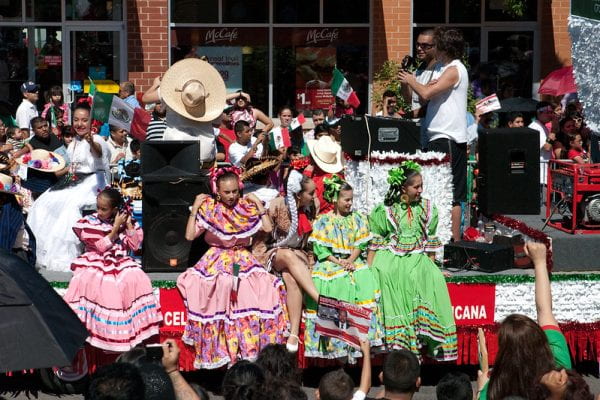City building by the Hispanic diaspora
Arturo Sánchez Navarro, MPP ‘24, University of Chicago Harris School of Public Policy
With migration to the United States from Latin America at record breaking levels, Mexico keeps standing as the top origin for migrants, particularly from the states of Jalisco, Michoacán, and Guanajuato; located in the center and north of the country. As of 2019, the predilect destinations for the community were the Los Angeles, Chicago, Houston, and Dallas metropolitan areas, hosting close to one third of all Mexican-born residents in the country. This trend of immigration to the Windy City dates back to the early 20th century, where socio-political turmoil during and after the Mexican Revolution led the population to seek better life conditions. To many, the American Dream meant a reassuring alternative within manageable distances, particularly for the northernmost states.

The Mexican Independence Day Parade in Chicago (Credit: soaringbird, Flickr)
After more than a century of continuous resettlement, a consolidated Chicano community has been pivotal in shaping the identity of present Chicago, inconceivable without the flavors, colors, charm (of course), and traditions of community building that have physically morphed the city around them. This organic appropriation of the urban space is palpable in two of the most authentic Mexican neighborhoods in the city: Little Village (better known as “La Villita”, by the locals), and Pilsen, founded by Czechs and reclaimed by Tex-Mex, both located in the southwest side of town.
As the popular expression states, “You could get out of Mexico, but Mexico won’t get out of you”, restating how ingrained most of our manners still remain abroad: a way of life that imports some of the common dwelling practices of the archetypal Latino extended family model. These housing habits revolve around the prevailing need of proximity to our relatives, (particularly to the matriarchal figures) resulting in a partial emancipation where regardless of how independent we may become, a visit to our mother or abuelita at walking distance is essential.
Likewise, the expansion or extension of the household in order to welcome the ever-growing family is a regular practice, allowing for instances where three and even four generations coexist in the same lot. As Mexicans, we never really leave the nest, we expand it; often improvising on the construction means and expecting that when the new generations arrive they too enlarge the roost. Accordingly, the constant exposure to these sort of Do It Yourself housing practices tend to permeate into other areas of the Mexican modalities of dwelling, such as the tendency to avoid third-party contractors during home building and remodeling tasks. In turn, this has facilitated their settling in districts initially regarded as somewhat unappealing, which eventually undergo a vibrant transition as the all-natural magic of the pueblo comes into play.
As the appropriation of the space transcends the private sphere, the streetscape morphs to the likeness of its users. Beyond the all-famous legacy of muralism and the never ending depiction of Frida Kahlo, less obvious transformations have allowed for the subtle flourishing of our not so subtle religious and economic practices. The former manifested as publicly displayed shrines, often devoted to Our Lady of Guadalupe, while the latter is evidenced by the practically permanent occupation of the street by local vendors, with La Garra as a favorite among Hispanic Chicagoans.
Moreover, Mexican-ruled urban spaces are also subject to temporary interventions under seasonal changes: from partial street closures during local festivities to complete district overruns for Día de Muertos and Cinco de Mayo (no, it is not Independence Day). This is when roads become dancefloors, and sidewalks turn into stands for the churning crowd to better witness the show. As stated elegantly by Jane Jacobs, “Cities have the capability of providing something for everybody, only because, and only when, they are created by everybody”, reminding us of the potential of the built environment to host a plethora of expressions, activities, and identities, beyond just serving as a driveway to connect drive-throughs.
Proudly put, we “mexicanize” everything we touch, from the household to the neighborhood, with the characteristic chaotic joy that drives us towards designing our own solutions. That said, with Chicago’s status as a sanctuary city, which represents a promising destination for immigrant arrival and naturalization, the tendency of relocation from its southern neighbor will most likely continue on the rise. At the end of the day, amidst the legal constraints a cousin’s call will be a good enough excuse to reunite after the diaspora and make ourselves at home again.
